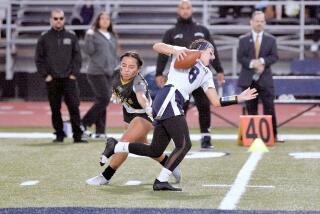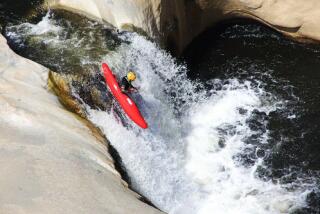Playing It Safe
- Share via
Swimming is a favorite summer pastime, especially for children, but with the fun comes increased danger.
The number of drownings countywide decreased in recent years, but last year they took a 23% jump and officials worry the trend could continue.
“My concern is they are getting complacent,” said Billie Weiss, director of the county’s Injury and Violence Prevention Program. “People think swimming pools are beautiful, but they forget the danger and risk to small kids.”
It is suggested that pool owners have several layers of protection in place to prevent drownings. Here are some tips for making the pool season safer.
Drownings
Total drownings in L.A. County
1992
Total drownings: 143
Pool or spa drownings: 73
*
1993
Total drownings: 134
Pool or spa drownings: 68
*
1994
Total drownings: 125
Pool or spa drownings: 58
*
1995
Total drownings: 113
Pool or spa drownings: 54
*
1996
Total drownings: 95
Pool or spa drownings: 46
*
1997
Total drownings: 117
Pool or spa drownings: 59
*
1998 (1)
Total drownings: 50
Pool or spa drownings: 16
*
(1) Note: Through June 21: Statistics comprise drownings in all locations including pools, bathtubs, open water and buckets.
Countywide drownings by age
*--*
Ages 1992 1993 1994 1995 1996 1997 1998(1) Birth to 4 21 35 25 31 17 21 7 5-19 16 14 13 10 8 17 7 20-49 67 44 52 37 41 40 14 50-79 31 28 24 22 21 27 15 80+ 8 13 11 13 8 12 7
*--*
(1) Note: Through June 21: Statistics comprise drownings in all locations including pools, bathtubs, open water and buckets.
Water Rescue
* When someone is in danger, the American Red Cross recommends: “Reach or throw, don’t go.”
* Reaching assist: If able to reach the victim, use a long object such as an oar, a paddle, tree branch or towel. Keeping weight low, lean away from victim, lying down or standing with legs bent and feet comfortably spread. Slowly bring victim in, using hand-over-hand grasp on the reaching object.
* Throwing assist: Using a throwing device such as a ring buoy, stay out of the water and stand with one foot forward and one back, keeping weight low. Hold device in dominant hand and hold extra line in other hand. Use underhand toss, aiming just beyond victim.
* Enter the water to rescue a victim only if you are confident of your swimming abilities and if conditions are safe.
* Information on swimming lessons: Call Valley Region Aquatics at (818) 765-0284 for information on lessons.
* Information on CPR lessons: American Red Cross (800) 627-7000.
Making Your Pool More Child Safe
Prevention at the Pool:
Fence: State law now requires new pools and spas have at least one of the following barriers between the home and the pool: a five-foot fence with self-latching gate that opens outward; alarms on all doors leading to the pool; self-closing and self-latching sliding glass doors with release button at 54 inches or higher; or an approved safety pool cover.
Rescue equipment: Life preserver rings with 50-foot lightweight line attached, life jackets and shepherd’s crook.
Phone: Have a cordless phone at poolside, in case of emergency.
Poolside Dangers: Keep toys away from pool, especially those a child rides.
Supervision: Children under 14 should be watched by an adult swimmer who knows CPR. The American Red Cross and local hospitals offer classes.
Safety Tips:
Look first in pool: Check for missing children in the pool or spa immediately. Most drownings occur when a child was last seen in the house or other part of the yard, not in the pool.
Brain damage: Toddlers can lose consciousness in just 30 seconds. Irreversible brain damage can occur after four to six minutes.
Screams: A drowning child may not be heard. Children are top heavy and tend to go in headfirst, without resurfacing.
Swimming lessons: Recommended by the city Department of Recreation and Parks beginning at age 3; the American Academy of Pediatrics warns that lessons for children under 4 may lead to a false sense of security.
Adults beware: Alcohol, drugs and swimming don’t mix. Never swim alone.
*
Sources: Los Angeles County Department of Health Services, Los Angeles County Department of Coroner, Los Angeles Building and Safety Department, American Red Cross, National Safety Council
Researched by STEPHANIE STASSEL / Los Angeles Times
More to Read
Sign up for The Wild
We’ll help you find the best places to hike, bike and run, as well as the perfect silent spots for meditation and yoga.
You may occasionally receive promotional content from the Los Angeles Times.






